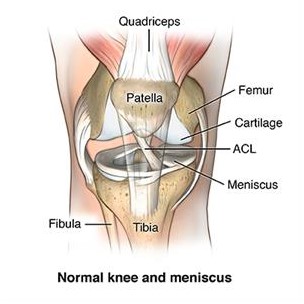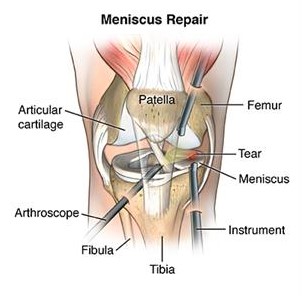Torn meniscus
A torn meniscus is a painful, but treatable, knee injury. Sports medicine specialists help you to heal and recover more quickly.
Torn meniscus
A torn meniscus is a painful, but treatable, knee injury. Sports medicine specialists help you to heal and recover more quickly.

What is torn meniscus?
There are 3 bones in the knee. These are the femur, tibia, and patella. The ends of those bones are covered with cartilage. This is a smooth material that cushions the bone and allows the joint to move easily without pain. The cartilage acts as a shock absorber. Between the bones of the knees are 2 crescent-shaped disks of connective tissue, called menisci. These also act as shock absorbers to cushion the lower part of the leg from the weight of the rest of the body.

What are the symptoms of torn meniscus?
Each person may have different symptoms. But the most common symptoms are:
- Pain, especially when holding the knee straight
- Swelling and stiffness
- Knee may catch, click, or lock
- Knee may feel weak or unstable
These symptoms may look like other health conditions or problems. Always talk with your healthcare provider for a diagnosis.
Torn meniscus care at UW Medicine
Choosing UW Medicine for your care means getting access to some of the most experienced physicians and surgeons in the country, many of whom have spent years caring for elite and high-level athletes who have ligament and meniscus injuries. The UW Medicine team helps care for athletes from the Seattle Seahawks, Washington Huskies and many youth sports leagues.
If you’re dealing with a torn meniscus, you can feel confident that you’re in good hands with the UW Medicine team. You’ll have the benefit of comprehensive care options ranging from bracing, to medication, to therapy, to surgery. Plus, your care team is most likely participating in innovative research while training the next generation of orthopedic and sports medicine physicians.
Some patients will be able to treat a meniscus tear with nonsurgical options. If you do need surgery, you can rest assured knowing our orthopedic surgeons are ranked among the best in the nation.
Orthopedics and sports medicine: our approach
What causes a torn meniscus?
Meniscus tears can happen during a rotating movement while bearing weight, such as when twisting the upper leg while the foot stays in one place during sports and other activities. Tears can be minor, with the meniscus staying connected to the knee. Or they can be major, with the meniscus barely attached to the knee by a cartilage thread.

How is a torn meniscus diagnosed?
Your healthcare provider will ask about your medical history and do a physical exam. You may also need:
- X-ray. This test uses invisible electromagnetic energy beams to make images of internal tissues, bones, and organs onto film.
- MRI. This test uses a combination of large magnets, radiofrequencies, and a computer to make detailed images of organs and structures within the body. It can often find damage or disease in a surrounding ligament, tendon, bone, or muscle.
- Arthroscopy. This is a minimally invasive procedure used for conditions of a joint. It uses a small, lighted, optic tube (arthroscope). The tube is inserted into the joint through a small incision in the joint. Images of the inside of the joint are projected onto a screen. They are used to evaluate any degenerative or arthritic changes in the joint. The procedure also may detect bone diseases and tumors, as well as determine the cause of bone pain and inflammation.

